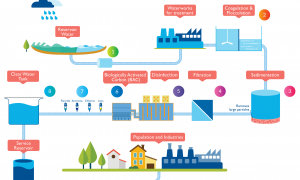🕑 Reading time: 1 minute
The passage of water from the main canal to the outlet at the head of the watercourse may experience water loss either due to evaporation or due to seepage. Evaporation and seepage loss in certain situations account to be very high at the rate of 25 to 50% of the water that is diverted to the main canal. These losses are studied and taken into consideration during the design of channel capacity.
The main two losses in channels due to evaporation and seepage are briefly explained in this article.
Contents:
Evaporation Losses in Channels
Evaporation loss in channels accounts for 2 to 3 percent of the total loss in channels. This loss occurs at a lesser rate compared to seepage losses in channels.
The evaporation loss is dependent on temperature, humidity, wind velocity etc. During summer, the evaporation losses are high but rarely exceed 7% of the total quantity of water that is diverted into the main canal.
Seepage Loss in Channels
The seepage loss in channels can be occured either through:
- Percolation
- Absorption
1. Percolation loss in Channels
In percolation loss, the water is lost through a continuous zone that is formed between the canal and the water table. This zone contains fully saturated soil which establishes a continuity of flow of water lost from the canal and joins the groundwater reservoir as shown in figure-1.

The 'H' difference between the top water surface level of the channel to the water table level influence the loss of water through percolation.
2. Absorption Loss in Channels
As shown in the figure-2, there exists a zone of saturated soil below the channels accompanied by a zone of soil with decreasing saturation, which in turn is bounded by a zone of soil which is saturated by the capillary action of water raising from the adjacent water table level.

Hence, from the figure, an unsaturated soil zone is bounded by two zones of sacturared soil.
If, 'H' is the seepage head, 'h' is the distance between the water surface level of the canal and the bottom of the saturated zone, 'hc' is the capillary head, then the rate of loss due to absorption is dependent on (h + hc).
Seepage loss in Canals is dependent on the following factors:
- Based on whether the seepage loss is due to percolation or through absorption.
- Permeability of the soil
- Canal Condition influences seepage loss. The loss in silted canal is less compared to new canals.
- Velocity of the canal water and the wetted perimeter.
- Amount of silt that is carried by the canal. More silt, less is the seepage loss.
Also Read: Canal Linings


